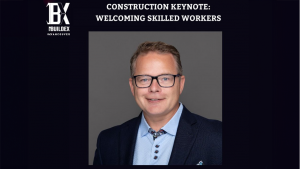The Architecture keynote panel held at Buildex Vancouver on Feb. 25 tackled design trends of both the present and future. Architecture critic Trevor Boddy was the moderator and the panelists were Alan Boniface of DIALOG, Jim Huffman of Perkins + Will, and Bruce Knapp of B+H Architects.
Boddy began by saying the focus would be on culture, materiality, and resilience. Knapp went on to give a tour of B+H‘s work, focusing first on materiality. 601 West Hastings in Vancouver is a façade on an office building which preserves a small park at the corner of the building. By using cast columns that grow as they rise and hold up a curved façade that allows sunlight to continue hitting the park.
The Ormindale Block is another Vancouver project which also opens up a façade-like archway at the bottom of the building. The Camosum College Centre for Trades Education and Innovation in Victoria, B.C. also has a large awning, which also acts as an open outdoor classroom so students can work with 18-wheel trailers. The new UBC Student Union Building is a "building of the future," which is considerably more open and well-lit than the previous dankly lit building. The SUB is LEED Platinum certified and grows food for the restaurants on the roof.
Resilience is reflected in a B+H project in Doha, Qatar, the Arab Centre for Research and Policy Studies. The building is made of limestone and is covered in Arabic poetry and philosophy writing on the building itself. Recladding was the focus of First Canadian Place in Toronto, after a marble slab panel dropped 60 stories. This is a growing trend with older buildings, Knapp said, and will have to be rapidly addressed. Marble panels were replaced with glass with cross hatching, and also revealed the facades of each side while doing so.
Huffman tackled the growing issues of autonomous cars, and how it will have a huge impact in the near future on the city and on design. He said youth are a culture that embraces car sharing, and is already glued to their smartphones, which makes self driving vehicles something that will be "totally acceptable" to them.
Huffman pointed to the on-demand nature of the vehicles, as cars come to you when you call them up and then leaves when you are finished with it. This frees up parking space which can then be used for other purposes.
"all you need on your street is a drop off," Huffman said. Parking areas can be reclaimed for habitable use, which Huffman said gives citizens a stronger connection to the city.
Autonomous cars create greener streets, an enhanced urban realm and resilient technology, Huffman concluded.
"We can claim back our streets and our spaces," he said.
Boniface started by saying he is a critic of Vancouver. "We rest on laurels of luxury in tha we’re a bounded city," he said. Vancouver has learned how to do density within certain constraints. He pointed to the rejection of freeways in downtown Vancouver as a fundamental decision shaping the city…but also leading to rejecting things that might have value.
Boniface said adding bike lanes really doesn’t address the future of the city, and pointed to taking down the Georgia viaducts as possibly a good idea "but we’ll probably just replace t with glass and grass," he said.
"And do we need formulaic neighbourhoods?" He posited. He said there’s a formula for how buildings are built here and it is being exported to the rest of the world.
Boniface also pointed to alleyways in Vancouver as unused, unlike the rest of the world where they are vibrant additions to the cityscape.
The Olympic Village is a place "growing into itself’ but it is a different attitude to the public realm and isn’t the usual cookie cutter towers, Boniface said.
One of Boniface’s pet issues, he said, was the idea of freezing industrial lands. He insists industrial and workspace should be built into workspaces and should not be rejected out of hand.





Recent Comments
comments for this post are closed